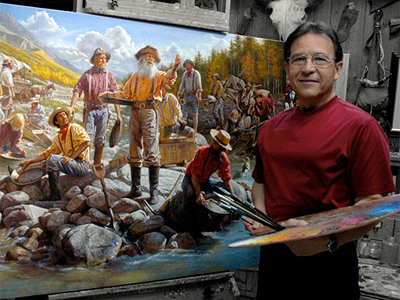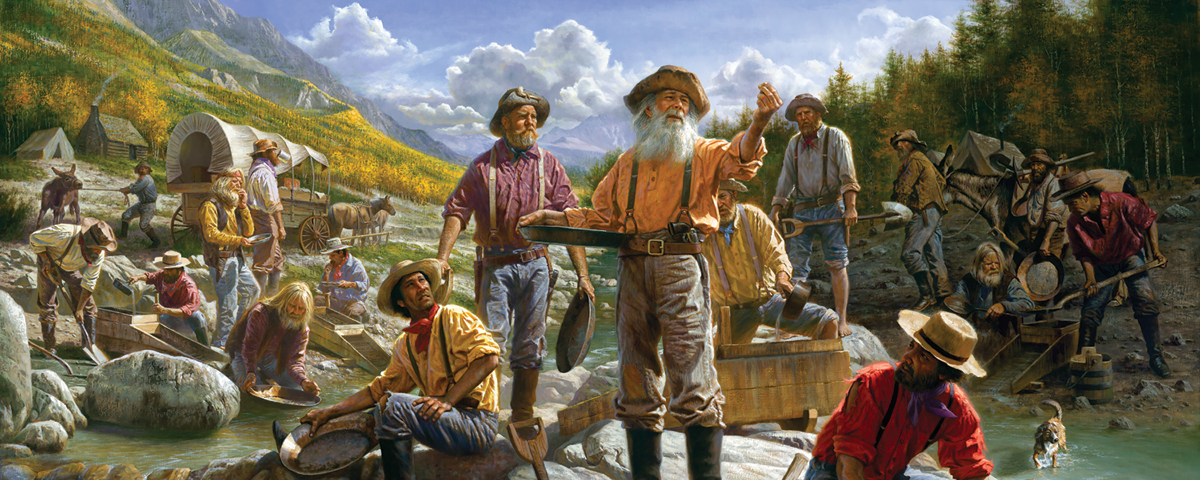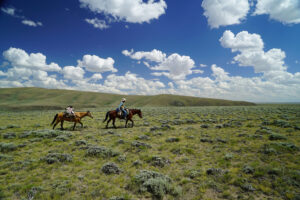Busy prospectors panning for gold along a Rocky Mountain streambed have cause to pause for a moment as one lucky old coot eyes a gleaming nugget in Alfredo Rodriguez’s Colorado Gold Rush, a 40-by-60-inch oil-on-linen the California artist did on commission. “It took about four months of research, and gathering models from many states, and countless hours sketching and painting to create the composition,” he recalls from his home in Corona, where he raised three daughters with wife Cheryl. “The results were just satisfactory to me, but I didn’t expect the tremendous and positive reaction from the thousands of people who saw the painting when it was exhibited.”

Like many artists, Rodriguez knew at an early age he had “a God-given talent to draw.” And like many others, he spent his childhood “playing baseball and soccer, going to school and watching Western movies.” But his story differs from most.
Rodriguez was born in 1951 into a family of 11 in Tepic, capital of the Pacific Coast state of Nayarit, Mexico. “We were very poor, but my parents used their savings to buy me a set of watercolors one Christmas night when I was 6 years old,” he recalls. “I discovered a new world of possibilities to create, experiment and explore.” He later took lessons from local art instructor Santiago Rosas. “That was my formal training,” he says.
“During elementary school in Mexico we used to take field trips to the Mexican Indian reservations, and my admiration toward the natives grew tremendously,” Rodriguez recalls. “Years later here in America I discovered that some of the Indians I paint, like the Navajos, Hopis and Apaches, have a lot of similarities with the Indians in Mexico—traditions, celebrations, even some clothing. So it wasn’t difficult for me to make the transition.”
The artist didn’t venture to the United States until 1975. When he paints men and women heading for new territories to better their lives, he can relate.
‘I was determined I was going to be an American and dedicate my life to painting the American West’
His love of classic Western films fueled his interest in the American West, and he resolved to venture north—“legally,” he affirms with a laugh—after hearing that Western art was gaining in popularity. “I went to school to study English and U.S. history the first day I stepped on American land,” Rodriguez recalls. “I was determined I was going to be an American and dedicate my life to painting the American West.” He became a U.S. citizen in 1989, and today the established artist is represented by Trailside in Jackson Hole, Wyo.; Settlers West in Tucson, Ariz.; and Huey’s Fine Art in Santa Fe, N.M.
“My work has been focused basically on the people of the American West,” Rodriguez says. “I love painting faces—wrinkles on an old man’s face, as well as the soft values of a baby’s skin or a prairie woman. I think a face can tell a story more eloquently than a multiple-figure scene. I love painting characters of the Old West—mountain men, cowboys, native Americans, old prospectors, as well as children, beautiful women in their environment and activities of the life of the late 1800s. I also like to paint relationships between families—an old man telling stories to his grandkids, or a mother reading a book to her children before going to bed, etc.”
In the early 1990s Rodriguez gave painting lessons to Pilar Wayne, the third wife and widow of Rodriguez’s childhood hero, John Wayne.
“I never imagined having the life I am having now in America, making a living doing something that I enjoy doing,” he says. “Now I paint pictures for a living in the land of my hero, John Wayne. Being a professional artist has not been easy. But I am enjoying the journey.” WW





